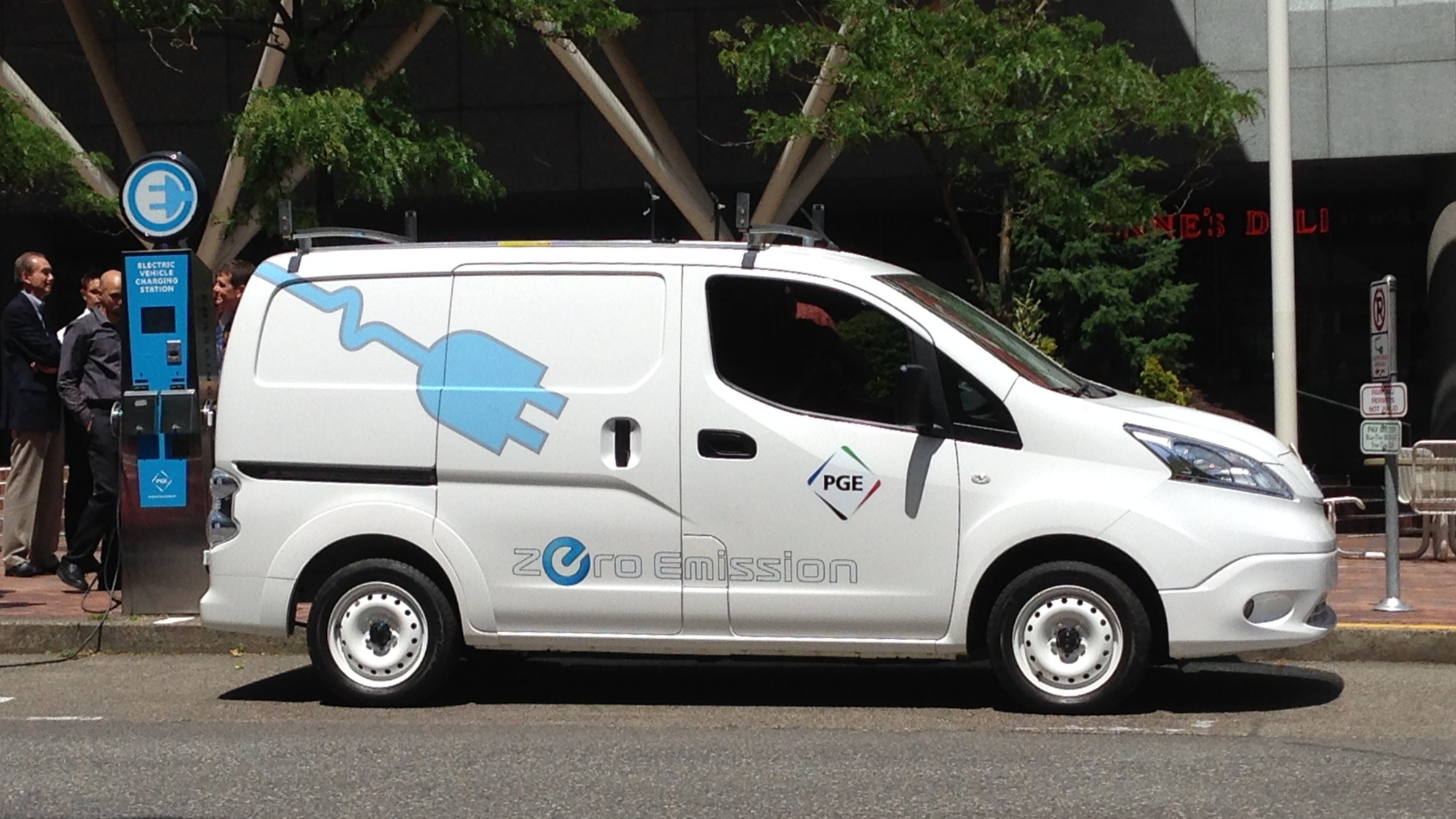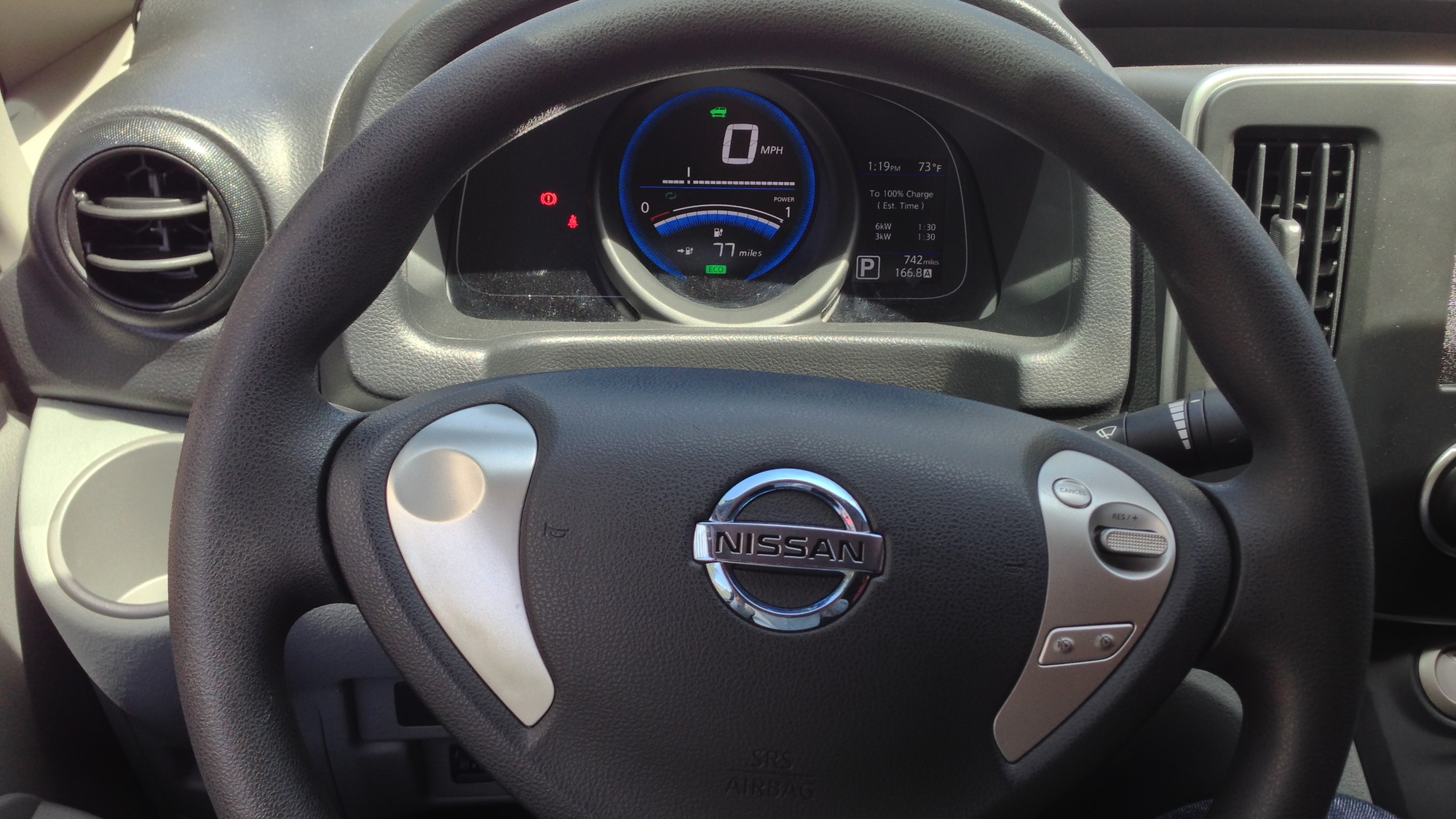What's it like? Frankly, it's a lot more like the current 2014 Nissan Leaf than we expected, with a relatively nimble, responsive feel.
That's no surprise, really. The front-wheel-drive, Barcelona-built e-NV200 has the same motor system, as well as many of the same drive components and controls, as the Nissan Leaf. Unladen, it weighs in the range of 300 to 400 pounds more than the Leaf; and it has, essentially the strut-type front end of a small car, grafted to the rear two thirds of a commercial van, with a solid axle and multi-leaf arrangement, controlled by twin-tube shocks.
The battery itself is also familiar territory. It's the exact same 24-kWh, air-cooled pack and 80-kW motor system that's used in the Leaf, and the battery is mounted just below the van's long, smooth cargo floor. Just like the Leaf, it has available fast-charge capability that can bring it up to 80 percent capacity in less than 30 minutes.
The driving position in the e-NV200 is quite different than in the Leaf, however; it's quite upright, with short lower cushions, and the steering column is far more vertical than any car or crossover. There's a lot of hard plastic ahead of the driver, and you can hear a metallic resonance if you tug the seatbelt; but hey, this is a commercial vehicle, and the treatment reflects a work environment—easy to wipe and keep clean. Yet the instrument panel is familiar—a version of the Leaf's gauge cluster, essentially.
Same motor and battery, same range game, too

Nissan e-NV200 - First Drive, June 2014
And those range concerns are largely the reason why the e-NV, which is launching for commercial sales this summer in Europe and in Japan in October, is strictly for test fleets for now. There really are just two in the U.S.; the other one is starting at Fedex in Washington, D.C., where it'll be used for deliveries.
One difference versus the Leaf is that there's a very pronounced two-stage (or three-stage, if you count the foot-to-the-floor detent) accelerator linkage in the e-NV200. As Nissan Light Commercial Vehicles product planner Evan Fulton conceded, is designed to remind those who are used to driving sometimes-underpowered gasoline commercial vans, and not electric vehicles, that the EV's instantaneous torque doesn't require a lead foot to feel sprightly at low speed.
Makes most other cargo vans feel cumbersome
Since the e-NV200 is relatively light for a van (just under 3,700 pounds), it feels eager to make quick directional changes, and you don't crash over pavement irregularities the way you do in some larger, heavier-duty cargo vans.
Who does Nissan have in mind for the e-NV200 in the U.S. Fulton points to contractor types who might just be headed to a work site for an inspection, with a clipboard and a pen.
“They don't need a heavy commercial vehicle that gets 10 miles per gallon for that,” Fulton said. “And then when you need seven or eight thousand pounds of equipment and gear, you send your full-size van...You optimize your operating costs that way.”

Evan Fulton and Jeannie Lam, of Nissan North America, with PGE's Charlie Allcock
“In many places, there is a no idling policy now, as more people are concerned about carbon emissions and fumes,” said Charlie Allcock, PGE's business development director.
Greenlight for the U.S. needs interest outside of 'green vehicle cities'
Fulton pointed to Portland, San Francisco, and Atlanta as cities that have had good adoption rates for electric cars, that might also be good for small commercial vehicles such as this.
What would a decision to bring the e-NV200 to the U.S. involve? According to Nissan light commercial vehicles product planner Evan Fulton, the e-NV as we tested it is still in overseas-market spec, as it's a limited fleet-test vehicle. To pass for sale here, it would probably also mean making some of the same structural changes—like adding an extra B-pillar reinforcement—that were required for the gasoline NV van.
That would all come at some undisclosed additional cost—which is likely why Nissan is hesitating to make sure there's some appeal
Incentives...hello?
Fulton also admitted that there's very little to help incentivize the cargo-van side of electric vehicles right now; any widespread move to do so in the U.S. would make Nissan's decision much easier. Such vehicles are heavily incentivized in Japan, for instance.
As it stands, the e-NV200 vans will stay with a series of different companies, changing hands every six weeks, for a year. And each of those were hand-selected through relationships with Nissan field representatives.
Is it worth that extra investment for North America? Fulton conceded that Nissan would need to anticipate moving tens of thousands e-NV200 vans over a few years to make it a worthwhile proposition, but hinted that it might take a fraction of that in early-adopter interest to jump in. “If we had, say, a thousand business owners waiting, we could move very quickly,” Fulton said.
_________________________________________

















